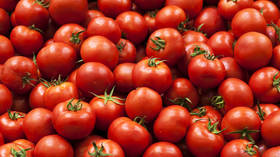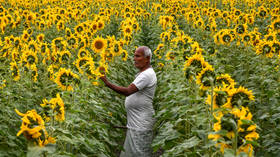Indians fume over 445% spike in tomato prices, experts blame rains and inefficient regulation

The price of tomatoes, a crucial ingredient in Indian cuisine, has skyrocketed by 445% after erratic rainfall and cyclones in southern and coastal regions where the crop is primarily cultivated. Abnormal heat followed by heavy rains, amid increasingly unpredictable climate patterns, have devastated tomato production in what was already a low-yield season.
Although tomato prices vary across India, the average cost has surged from 20-30 rupees ($0.24 to 0.36) to well over 100 rupees ($1.21) per kilogram in more than 50 cities, making it costlier than a liter of car fuel. In the northern state of Uttarakhand, tomato prices have climbed as high as 250 rupees ($3.03) per kilogram.
Social media in India has been flooded with memes comparing tomatoes with anything from gold and other luxury items to high-yield stocks. Recipes for Indian dishes without tomatoes have been some of the most popular reads in the Indian media in the past two weeks.
च्यामाइला इतनी हेराफेरी 🤦🏻♂️🤷🏻♂️#TomatoPricepic.twitter.com/BU1rMsMVZM
— बाबूराव गणपतराव आप्टे (@baburao__aapte) July 5, 2023
The five-fold price surge hasn’t just hurt households. The US fast food giant McDonald’s has stopped using tomatoes in its meals at the majority of its outlets in northern and eastern India.
This pamphlet has been pasted outside Connaught Place saying that, After the increase in the price of tomatoes in the market, tomatoes are still not available for the items in which tomatoes were used in #McDonalds.@mcdonaldsindia#TomatoPrice#Delhipic.twitter.com/eRuxM5soCm
— Himanshu Purohit (@Himansh256370) July 7, 2023
Devinder Sharma, an agricultural economist, told the CNBC-TV18 news channel that prices are likely to ease in August once the yield increases. He also argued that high fluctuations in prices of vegetables that either surge, hurting consumers, or crash, hitting farmers, should be addressed by stricter regulations in the retail sector. Ajay Kedia, a Mumbai-based commodity market expert and head of the Kedia Advisory, told ANI news agency that many tomato farmers switched to growing beans this year, eyeing better margins since the price of the vegetable surged last year. On the other hand, heavy rainfall has dampened that crop’s output as well.
Tomato prices have undergone extreme volatility for several years in India. In July 2020, amid the first wave of the Covid-19 pandemic, tomato prices dipped by up to 2 rupees ($0.024) per kilogram, as farmers grappled with massive debts, weighed down by skewed demand and supply. Data from the Ministry of Consumer Affairs, Food and Public Distribution shows that the tomato price at the beginning of this year was 22 rupees ($0.27) per kilogram. Tomatoes are largely grown in Andhra Pradesh, Madhya Pradesh, Karnataka, Gujarat, Odisha, West Bengal, Maharashtra, Chhattisgarh, Bihar, Telangana, Uttar Pradesh, Haryana and Tamil Nadu. Usually, tomatoes get expensive during the lean production months of June-July and again in October-November, Bloomberg reported, quoting Rohit Kumar Singh, secretary of the Consumer Affairs Department at the ministry.
Anil Malhotra, a member of the Azadpur Agricultural Produce Marketing Committee (APMC) in Delhi, said that while tomato prices shoot up every monsoon, they were never this high. “There is a major dip in supply due to the rains. Around half of our stock, which we got from Himachal Pradesh, got damaged,” Malhotra told the PTI news agency.
Experts have warned that a spike in food prices could impede the Reserve Bank of India’s (RBI) efforts to drive economic growth, which is projected at 7% for the current financial year, and keep inflation under control. Consumer inflation dropped to 4.5% in May, falling to its lowest in 25 months and remaining within the central bank's target range of 4% plus or minus 2% for the third straight month. However, this month, India's consumer price index (CPI) is expected to see an increase.
Kaushik Das, chief India economist at Deutsche Bank AG, said the delay in the monsoon could result in a potentially sharp spike in food price inflation in July, by about 2.6% month-on-month, which could push the CPI inflation trajectory above the 5.5% mark in the July-September period. Vegetables have a 6% weighting in India’s CPI basket and this unusual increase is likely to push headline inflation to 4.5% in June, and potentially closer to 5.5% in July-August, if current trends persist, according to the financial advisory firm Nomura. The sharp increase in the prices of tomatoes, pulses and rice, are likely to push food inflation to 4% year-on-year in June from 3.3% in May, according to Bloomberg Economist Abhishek Gupta.
The prices of kitchen staples are an emotive issue in India and have even brought down state governments in the past. For instance, the Bharatiya Janata Party’s (BJP) government in Delhi in 1998 – the last time the right-wing party held power in the national capital – became an object of ridicule over high onion prices, and was eventually voted out.
With memories of that episode very much alive for Prime Minister Narendra Modi’s government, it has turned to the public to find a long-term solution. The government has announced a ‘Tomato Grand Challenge Hackathon’ in New Delhi, inviting students, researchers, business and start-ups to suggest innovative ideas “at various levels of the tomato value chain” to ensure affordable prices for consumers and help tomato farmers get value for their produce.













